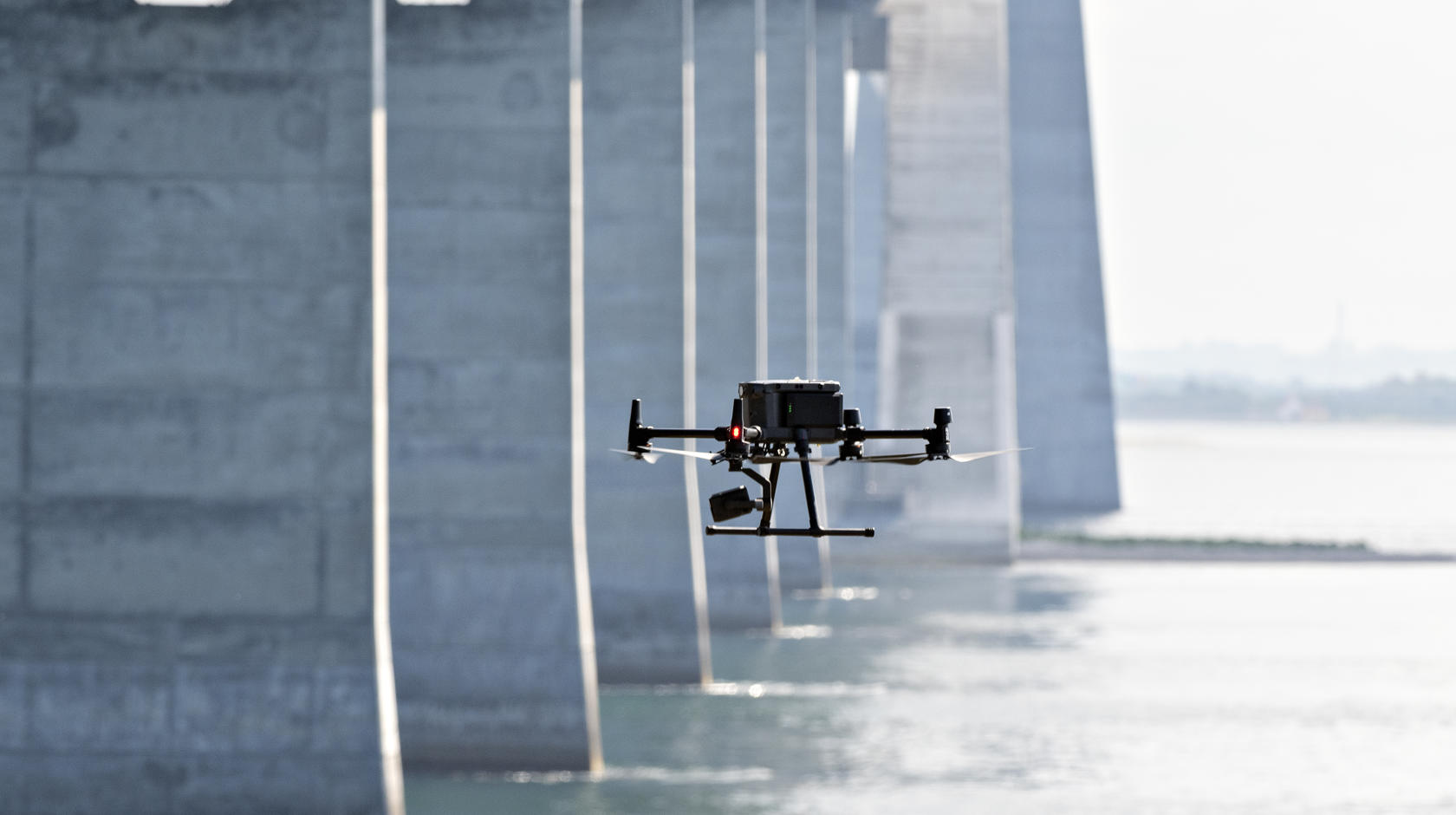Since it opened in 1998, Storebælt’s High Bridge has been exposed to pretty much everything that can affect the condition of the bridge piers and the bridge itself: storms, sunshine, rain, snow, and not least, wear and tear from traffic. With new technologies, however, Sund & Bælt is able to streamline operations while simultaneously ensuring a longer service life for the link.
From climbers to drones: working hours fall by two thirds
The bridge piers were originally inspected by climbers who could swing around the 6,000-tonne pylons using ropes or inspection platforms with crew baskets that could run up and down the surfaces. Observed damage that posed a threat to the condition of the concrete, e.g. cracks and rust, was recorded using paper and pencil. This was not without safety risks. A boat followed the climbers from pylon to pylon so that the crew could get safely ashore should accidents occur.
That procedure was last used in 2016. The concrete is now inspected by a swarm of drones. Svend Gjerding, Operations Manager at Sund & Bælt, explains:
“The drone that we use is equipped with a special camera where we can mark a given area. The drone then takes photos in a systematic way, which ensures that the entire concrete surface of the pier is photographed and that all cracks and other damage are recorded. With a processing time of 3-5 minutes, this means that it takes a total of five days to inspect all the bridge piers. It previously took up to three weeks.”
According to Svend Gjerding, the challenge of using the drone for inspections is the weather. It must be relatively calm, with no rain and the sun shouldn’t be too bright.
However, the huge benefits of the drone inspections outweigh the challenges. With a strategy of using technology to reduce operating and maintenance costs by 2 per cent per year, the drone is a clear step forward in achieving this objective.
“We have a better tool to monitor wear and tear. In the long term this means that we can predict when it will occur and, ideally, avoid major and expensive damage entirely.”
Svend Gjerding, Sund & Bælt
Technology contributes to a longer service life and healthier green accounts
The drone does not just reduce the inspection time out on the water. When the inspection is complete, the images are copied into the Photographic Asset Inspection (PAI) application, which analyses them. The technologies ensure an automated method for detecting and analysing damage in the concrete and contribute a systematic overview of the condition of the bridge piers:
“With the technologies available, we get a better tool to track the development of the damage. This means that we can predict when the damage will occur and, ideally, avoid major and expensive damage entirely,” says Svend Gjerding.
The precise picture of the bridge's condition in conjunction with the technology of the future means that the Storebælt Bridge will receive better timed maintenance. Ultimately, this means that its service life is expected to be 200 years compared to the 100 years for which it was originally designed.
This outcome has a clear financial benefit. This is not the only reward, however, the climate and the green accounts also gain from the technological possibilities.
“The green accounts also benefit from the extended service life. The bridge's steel superstructure and concrete save around 750,000 tonnes of CO2 over 100 years. This corresponds to the annual CO2 emissions of 52,000 households,” says Svend Gjerding.
Drone inspection and PAI facts
- The drone is controlled via a joystick from a boat or from the anchor block.
- The drone ascends and hovers in a stable position approx. 10 metres from the concrete surface. The number of photos taken depends on how close the camera is to the surface as well as its resolution and zoom.
- PAI has an algorithm that is designed to detect typical concrete damage.
- The algorithm tags the images where it thinks there is damage. These are eventually verified and described by an engineer.
- When PAI has completed the entire inspection, the material is handed over to contractors who will ultimately conduct the repairs.
- Some issues can reduce effective drone operation. These include loss of control when flying under the bridge due to reduced satellite contact; and the concrete reflecting bright sunlight so that neither engineers nor PAI can identify damage.
